
International Journal of Mathematical Education in Science and Technology
Scope & Guideline
Elevating Learning: Where Mathematics Meets Innovation
Introduction
Aims and Scopes
- Mathematics Education Research:
The journal emphasizes empirical research that investigates teaching and learning processes in mathematics, exploring how students understand mathematical concepts and the pedagogical approaches that best support this understanding. - Integration of Technology:
A core area of focus is the use of technology in mathematics education, examining how digital tools, software, and online platforms can enhance learning experiences and outcomes for students at various educational levels. - Innovative Teaching Strategies:
The journal publishes studies on innovative teaching methods, including inquiry-based learning, blended learning, and active learning strategies, aimed at improving students' engagement and achievement in mathematics. - Curriculum Development and Evaluation:
There is a strong emphasis on curriculum development, evaluation, and reform, particularly in relation to how mathematics is taught in primary, secondary, and tertiary education, ensuring that curricula meet the evolving needs of learners. - Interdisciplinary Connections:
The journal explores the connections between mathematics and other disciplines, particularly STEM fields, and how these interdisciplinary approaches can enrich mathematics education and promote critical thinking among students. - Equity and Diversity in Mathematics Education:
Research addressing issues of equity, diversity, and inclusion in mathematics education is a significant focus, investigating how various factors such as race, gender, and socioeconomic status influence students' learning experiences and outcomes.
Trending and Emerging
- Online and Blended Learning:
The impact of online and blended learning models has surged, particularly following the COVID-19 pandemic, leading to an increase in studies exploring their effectiveness and best practices in mathematics education. - Mathematical Modelling:
There is a growing emphasis on mathematical modelling as a pedagogical tool, with research exploring how it can enhance problem-solving skills and facilitate deeper understanding of mathematical concepts among students. - Social Justice in Mathematics Education:
Emerging research focuses on social justice issues within mathematics education, examining how teaching practices can be adapted to promote equity and inclusion for diverse student populations. - Cognitive and Affective Factors in Learning:
An increasing number of studies are investigating the cognitive and emotional aspects of learning mathematics, such as anxiety, motivation, and self-efficacy, and their influence on student performance. - Use of Artificial Intelligence and Digital Tools:
The integration of AI and advanced digital tools in mathematics education is on the rise, with research exploring their potential to personalize learning and enhance student engagement. - Collaborative Learning Environments:
Research highlighting collaborative learning strategies is trending, emphasizing the importance of peer interactions and group work in fostering a deeper understanding of mathematical concepts.
Declining or Waning
- Traditional Lecture Methods:
There is a noticeable decline in papers focusing on traditional lecture-based teaching methods, as the field increasingly favors more interactive and student-centered approaches to mathematics education. - Focus on Pure Mathematics:
Research centered on pure mathematics concepts, without direct applications to teaching and learning, has diminished, reflecting a shift towards studies that integrate practical applications and real-world relevance in mathematics education. - Standardized Testing Practices:
The discourse around standardized testing and assessment methods in mathematics has waned, as educational research shifts towards more formative and authentic assessment practices that better capture student learning. - Historical Perspectives in Mathematics Education:
While historical analyses of mathematics education have been relevant, this theme has seen less frequency in recent publications, indicating a move towards contemporary issues and practices that directly impact current educational settings. - Single-Discipline Studies:
There is a decreasing focus on studies that examine mathematics education in isolation, with a growing trend towards interdisciplinary research that connects mathematics to other subjects and real-world applications.
Similar Journals

International Journal for Technology in Mathematics Education
Connecting research and practice in math education technology.International Journal for Technology in Mathematics Education (ISSN: 1744-2710, E-ISSN: 2045-2519) is a pioneering platform published by Research Information Ltd that focuses on the interplay between technology and mathematics education. Established to bridge the gap between pedagogical practices and technological advancements, this journal connects researchers, educators, and practitioners in a bid to enhance teaching methodologies and optimize learning outcomes in mathematics. Although its coverage in Scopus was discontinued after 2020, it continues to be a vital resource for those interested in the integration of technology into educational settings. With its significant emphasis on interdisciplinary approaches, the journal has garnered attention in the realms of social sciences and computer science, with Scopus rankings reflecting its niche contributions. This journal is crucial for professionals aiming to explore innovative techniques in mathematics education, making it an invaluable addition to any academic library.
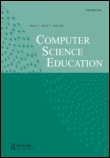
Computer Science Education
Pioneering Research for a New Era of Computer Science EducationComputer Science Education is a prestigious journal published by ROUTLEDGE JOURNALS, TAYLOR & FRANCIS LTD, focusing on the critical intersection of computer science and educational practices. Established in 1988, this journal has become a cornerstone for researchers, educators, and practitioners interested in enhancing teaching methodologies and learning outcomes in computer science. With an impressive ranking within the top quartile (Q1) in both Computer Science (miscellaneous) and Education categories for 2023, as well as high Scopus percentile placements, it underscores its significance in advancing the discipline. The journal offers a platform for innovative research encompassing diverse educational environments and approaches, and while it currently does not offer open access options, it remains committed to disseminating high-quality scholarly work. As a vital resource for anyone looking to contribute to and understand the evolving landscape of computer science education, Computer Science Education continues to shape the future of learning in this dynamic field.
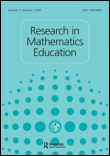
Research in Mathematics Education
Shaping the Landscape of Mathematics Education ScholarshipResearch in Mathematics Education is a premier academic journal published by Routledge Journals, Taylor & Francis Ltd, focusing on the critical field of mathematics education. Established in 1998, this journal has earned a reputation for fostering innovative scholarship and research that advances the understanding of teaching and learning mathematics. With its impressive Q2 ranking in both Education and Mathematics (miscellaneous) categories for 2023, and a notable Scopus rank of 60th in General Mathematics, it serves as a vital resource for researchers, educators, and policymakers alike. While it does not offer Open Access, the journal’s rigorous peer-reviewed framework ensures that only high-quality articles are published, contributing significantly to both theoretical and applied aspects of mathematics education. Its commitment to excellence is reflected in its ongoing aim to disseminate impactful research, making it an indispensable resource in the academic and educational communities.
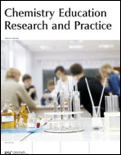
Chemistry Education Research and Practice
Connecting Research and Practice to Enhance Chemistry EducationChemistry Education Research and Practice is a prominent journal dedicated to advancing the field of chemistry education through rigorous research and innovative practices. Published by the Royal Society of Chemistry, this journal, with an ISSN of 1109-4028 and an E-ISSN of 1756-1108, operates out of Greece and has established itself as a leading voice in the intersection of chemistry and educational methodology. With a remarkable impact factor and ranking in the top quartiles (Q1) for both Chemistry and Education in 2023, it appeals to a diverse audience of researchers, educators, and practitioners who are passionate about enhancing chemistry instruction and learning experiences. The journal spans a wide range of topics, aiming to promote and disseminate high-quality research that informs pedagogical strategies, curriculum development, and educational policy. By providing a platform for vibrant discussions and new ideas, Chemistry Education Research and Practice plays a crucial role in shaping the future of chemistry education worldwide and continues to impact the academic community significantly.
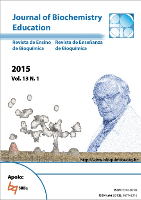
Revista de Ensino de Bioquimica
Championing Innovative Pedagogy in BiochemistryRevista de Ensino de Bioquimica, published by the SOC BRASILEIRA BIOQUIMICA & BIOLOGIA MOLECULAR, stands as an essential platform for advancing the field of biochemistry education. With an ISSN of 2318-8790 and an established open access model since 2001, the journal entices a diverse audience including researchers, educators, and students who are committed to the enhancement of teaching methods and learning strategies in biochemistry. The journal is dedicated to promoting innovative pedagogical practices and fostering scholarly dialogue in order to improve educational outcomes and engagement in the biosciences. Notably based in Sao Paulo, Brazil, the journal is pivotal for disseminating vital research and insights that can assist academic institutions and practitioners globally. Readers can access a wealth of knowledge that aims to bridge the gap between biochemical research and education, ensuring the continuous evolution of the discipline.
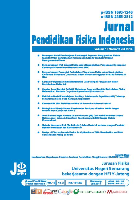
Jurnal Pendidikan Fisika Indonesia-Indonesian Journal of Physics Education
Advancing Physics Education Through Collaborative ResearchJurnal Pendidikan Fisika Indonesia-Indonesian Journal of Physics Education is a premier open-access journal dedicated to advancing research and pedagogy in the field of physics education. Published by Universitas Negeri Semarang, this journal aims to provide a platform for educators, researchers, and professionals to disseminate innovative teaching practices, empirical studies, and theoretical insights that contribute to the enhancement of physics education globally. With a commitment to accessibility since its inception in 2009, the journal is instrumental in fostering collaboration and knowledge sharing across the international physics education community. The journal not only serves as a vital resource for scholars and practitioners but also plays a significant role in shaping the future of physics teaching and learning in Indonesia and beyond. Researchers and educators are encouraged to submit their manuscripts to engage with the latest trends and research in this dynamic field.
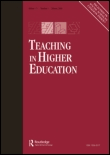
TEACHING IN HIGHER EDUCATION
Shaping the dialogue on curriculum development and pedagogy.TEACHING IN HIGHER EDUCATION is a premier academic journal published by Routledge Journals, Taylor & Francis Ltd, dedicated to advancing the scholarship and practice of teaching within the higher education sector. With an ISSN of 1356-2517 and an E-ISSN of 1470-1294, this journal is widely recognized for its profound impact in the field, boasting a 2023 category rank of Q1 in Education, placing it in the top tier of educational research. Its commitment to fostering an inclusive and dynamic discourse on pedagogical methods and learning frameworks makes it essential reading for researchers, educators, and policymakers alike. Spanning topics such as student engagement, curriculum development, and innovative teaching strategies, TEACHING IN HIGHER EDUCATION aims to contribute to ongoing conversations and practical applications that enhance the educational landscape. While an Open Access option is not available, the journal maintains a robust readership, with its articles being rigorously peer-reviewed and disseminated to reflect cutting-edge research trends and practices in education.

International Journal of Education and Information Technologies
Pioneering Insights at the Intersection of Education and TechnologyWelcome to the International Journal of Education and Information Technologies, a leading academic platform published by NORTH ATLANTIC UNIV UNION-NAUN. With an emphasis on the integration of education and information technology, this journal aims to foster innovative research and discussions that enhance pedagogical practices and technological advancements in educational contexts. Although currently an open access journal, it provides unrestricted access to emerging studies that are crucial for educators, researchers, and professionals aiming to stay at the forefront of education technology. While specific metrics such as H-index and Scopus ranks are yet to be defined, its ISSN 2074-1316 signifies its credibility and commitment to quality scholarship. This journal serves as a vital resource for those passionate about bridging the gap between technology and education, encouraging impactful research that shapes the future of learning environments.
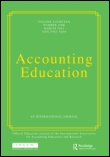
Accounting Education
Exploring New Frontiers in Accounting LearningAccounting Education is a leading academic journal dedicated to advancing the field of accounting education, published by Routledge Journals, Taylor & Francis Ltd. With an impressive Q1 ranking in both the fields of Accounting and Education, the journal serves as a vital platform for educators, researchers, and practitioners interested in the evolving pedagogies and methodologies in accounting education. The journal’s focus is on disseminating high-quality research that addresses contemporary challenges and innovations within accounting teaching, supported by an extensive archive from 1992 to the present. While currently not open access, the journal is known for its rigorous peer-review process, ensuring that only the most impactful research is published. With its high Scopus rankings, including a notable 92nd percentile in Business, Management and Accounting, Accounting Education provides invaluable insights and fosters professional development, making it an essential resource for anyone committed to enhancing accounting education.

Teaching Statistics
Cultivating Knowledge, Inspiring Educators in Statistics.Teaching Statistics is a peer-reviewed journal published by Wiley, dedicated to the advancement of statistical education and pedagogical methodologies. With its ISSN 0141-982X and E-ISSN 1467-9639, this esteemed journal has been an integral resource since its inception in 1979, providing a platform for innovative research and practices aimed at enhancing teaching effectiveness in statistics across various educational levels. Housed in the United States, it maintains a significant global presence and engagement, evidenced by its Q3 quartile rankings in both the Education and Statistics and Probability categories as of 2023. Furthermore, it holds commendable Scopus rankings, reflecting its influence in the fields of Mathematics and Social Sciences. Although not an Open Access journal, it fosters a wealth of knowledge beneficial to researchers, educators, and students alike, striving to elevate the standards of statistics education through comprehensive discussions and analyses. Through its commitment to the dissemination of valuable insights and resources, Teaching Statistics continues to be a vital asset for academic and professional communities seeking to enhance statistical learning and teaching methodologies.